United States Air Force Video - Picture
|
|
United States Air Force
Department of the Air Force United States Air Force
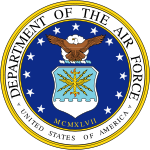
Active: September 18, 1947 - Present
Country: United States of America
Branch: Air Force
Size: 329,638 active personnel
68,872 reserve personnel
94,597 air guard personnel
5,573 aircraft, of which 2,132 are fighters
450 ICBMs
32 satellites
Part of: Department of Defense
Headquarters: The Pentagon
Motto: "Aim High ... Fly-Fight-Win'also '"Above All" and "No One Comes Close"
Colors: Ultramarine Blue & Yellow
March: The U.S. Air Force
Engagements: Korean War
Vietnam War
Gulf War
Bosnian War
Kosovo Campaign
Afghanistan War
Iraq War
Commanders:
Secretary: Hon. Michael B. Donley
Chief of Staff: Gen Norton A. Schwartz
Vice Chief of Staff: Gen Philip M. Breedlove
Chief Master Sergeant: CMSAF James A. Roy
Insignia:
United States Air Force Symbol:
USAF "Hap" Arnold Symbol:
Roundel:
USAF Pipe Band Tartan:
Aircraft flown:
Attack: A-10, AC-130
Bomber: B-52H, B-1B, B-2
Electronic
warfare: E-3, E-8, EC-130
Fighter: F-15C, F-15E, F-16, F-22
Helicopter: UH-1N, HH-60
Reconnaissance: U-2, RC-135, RQ-4, RQ-1
Trainer: T-6, T-38, T-1, TG-10
Transport: C-130, C-135, KC-135, C-5, C-9, KC-10, C-17, VC-25, C-32, CV-22, C-37, C-21, C-12, C-40.
The United States Air Force (USAF) is the aerial warfare service branch of the United States Armed Forces and one of the American uniformed services. Initially part of the United States Army, the USAF was formed as a separate branch of the military on September 18, 1947 under the National Security Act of 1947. It is the most recent branch of the U.S. military to be formed. The USAF articulates its core functions in its 2010 Posture Statement as Nuclear Deterrence Operations, Special Operations, Air Superiority, Global Integrated ISR, Space Superiority, Command and Control, Cyberspace Superiority, Personnel Recovery, Global Precision Attack, Building Partnerships, Rapid Global Mobility and Agile Combat Support.
As of 2009 the USAF operates 5,573 manned aircraft in service (3,990 USAF; 1,213 Air National Guard; and 370 Air Force Reserve); approximately 180 unmanned combat air vehicles, 2,130 air-launched cruise missiles, and 450 intercontinental ballistic missiles. The USAF has 330,159 personnel on active duty, 68,872 in the Selected and Individual Ready Reserves, and 94,753 in the Air National Guard as of September 2008. In addition, the USAF employs 151,360 civilian personnel, and has over 60,000 auxiliary members in the Civil Air Patrol, making it the largest air force in the world.
The Department of the Air Force is headed by the civilian Secretary of the Air Force who oversees all administrative and policy affairs. The Department of the Air Force is a division of the Department of Defense, headed by the Secretary of Defense. The highest ranking military officer in the Department of the Air Force is the Chief of Staff of the Air Force.
Mission
According to the National Security Act of 1947 (61 Stat. 502), which created the USAF:
In general the United States Air Force shall include aviation forces both combat and service not otherwise assigned. It shall be organized, trained, and equipped primarily for prompt and sustained offensive and defensive air operations. The Air Force shall be responsible for the preparation of the air forces necessary for the effective prosecution of war except as otherwise assigned and, in accordance with integrated joint mobilization plans, for the expansion of the peacetime components of the Air Force to meet the needs of war.
In general the United States Air Force shall include aviation forces both combat and service not otherwise assigned. It shall be organized, trained, and equipped primarily for prompt and sustained offensive and defensive air operations. The Air Force shall be responsible for the preparation of the air forces necessary for the effective prosecution of war except as otherwise assigned and, in accordance with integrated joint mobilization plans, for the expansion of the peacetime components of the Air Force to meet the needs of war.
§8062 of Title 10 US Code defines the purpose of the USAF as:
to preserve the peace and security, and provide for the defense, of the United States, the Territories, Commonwealths, and possessions, and any areas occupied by the United States;
to support national policy;
to implement national objectives;
to overcome any nations responsible for aggressive acts that imperil the peace and security of the United States.
The stated mission of the USAF today is to "fly, fight, and win in air, space, and cyberspace".
Operational functions
The Air Force describes its mission in terms of 17 operational functions:
Strategic Attack - offensive action that most directly achieves national security objectives by affecting the adversary’s leadership, conflict-sustaining resources and strategy.
Counter-air - operations to attain and maintain a desired degree of air superiority by the destruction, degradation, or disruption of enemy forces. Counter-air takes the form of both [[offensive counter-air]] against enemy air and missile power at its source, and defensive counter-air against attacking enemy air and missiles over friendly territory.
Counter-space - destruction, degradation or disruption of enemy space capability.
Counter-land - air and space operations against enemy land forces, including air interdiction to divert, disrupt, delay, or destroy the enemy’s surface military potential before it can be used effectively against friendly forces, and close air support to help friendly surface forces in contact with enemy forces.
Counter-sea - tasks including sea surveillance, anti-ship and anti-submarine warfare, aerial minelaying, and air refueling in support of naval campaigns.
Information Operations - actions taken to influence, affect, or defend information, systems, and/or decision-making, through influence, network warfare, and electronic warfare operations.
Combat Support - capabilities, functions, activities, and tasks necessary to create and sustain air and space forces, including the procurement, maintenance, distribution, and replacement of personnel and materiel.
Command and Control - exercise of authority and direction by a properly designated commander over assigned and attached forces in the accomplishment of the mission, including both process and systems.
Airlift - transportation of personnel and materiel through the air.
Air Refueling - in-flight transfer of fuel between tanker and receiver aircraft.
Space-lift - delivery of satellites, payloads and materiel to space.
Special Operations - airpower conducting unconventional warfare, direct action, special reconnaissance, counter-terrorism, foreign internal defense, psychological operations, and counter-proliferation.
Intelligence - product resulting from the collection, processing, integration, analysis, evaluation and interpretation of available information concerning foreign countries or areas.
Surveillance and Reconnaissance - systematic observation of air, space, surface, or subsurface areas, places, persons, or things, by visual, aural, electronic, photographic, or other means. Surveillance is a continuing process, not oriented to a specific target, while reconnaissance looks for specific information and generally has a time constraint.
Combat Search and Rescue - recovery of isolated personnel with rotary- and fixed-wing aircraft.
Navigation and Positioning - provision of accurate location and time of reference.
Weather Services - environmental information, including both space environment and atmospheric weather.
Search and rescue
The National Search and Rescue Plan designates the United States Coast Guard as the federal agency responsible for maritime search-and-rescue (SAR) operations, and the USAF as responsible for aeronautical SAR in the continental U.S. with the exception of Alaska. Both agencies maintain Joint Rescue Coordination Centers to coordinate this effort. To help the USAF with the vast number of search and rescue operations, the USAF assigns units of the Civil Air Patrol - the official U.S. Air Force Auxiliary - in over 91% of inland search and rescue missions.
Air sovereignty
The USAF, through the Air National Guard, is the lead agency to maintain control of America's airspace.
On July 30, 2009, Lt. Gen. Harry Wyatt, director of the Air National Guard said that "Technologies needed for the mission include an active, electronically scanned array radar (which can be used to detect small and stealthy air threats including cruise missiles), infrared search and track systems and beyond-line-of-sight communications".
On September 14, 2009, Gen. Norton A. Schwartz, chief of staff of the USAF, said that he hopes "to bring a combination of F-22, F-35, legacy aircraft, including upgraded F-15 and F-16 fighters, and unmanned aircraft to the [air sovereignty alert] ASA mission."
Even so, the USAF plans to retire up to 80% of their total force air sovereignty mission aircraft, which would leave no usable aircraft at 18 current air sovereignty sites after 2015. The GAO found that 17 of the 20 commanders of the ASA units "stated that the Air Force treats ASA operations as a temporary mission and has not provided sufficient resources."
The USAF has decided to accept "moderate risk" for the air sovereignty mission as well as deep strike and close air support, under optimistic assumptions for F-35 production.
The Defense Department has used USN and USMC aircraft for the Air Sovereignty Mission and may do so in the future.
Irregular warfare
In response to the conflicts in which the United States has been engaged since the end of the Cold War, on August 1, 2007, Air Force Doctrine Document 2-3 was released showing how air power could be used to support or defeat an insurgency.
To support these missions, the USAF considered outfitting a counter-insurgency wing with small, ground attack aircraft that can also be used for training USAF and allied pilots in addition to counterinsurgency operations. However the 2010 QDR shifted the future light fixed-wing aircraft to the Air Force’s 6th Special Operations Squadron to be used to train allied forces.
Airlift
The USAF provides both strategic and tactical airlift in support of wartime, peacetime, and humanitarian efforts of the Department of Defense.
The GAO found that Air Force plans should cover strategic airlift, but that it may fall short in providing tactical airlift in support of the United States Army.
History
The Army created the first antecedent of the USAF in 1907, which through a succession of changes of organization, titles, and missions advanced toward eventual separation 40 years later. The Air Force came of age in World War II. Almost 68,000 U.S airmen died helping to win the war, only the infantry suffered more enlisted casualties. In practice, the USAAF was virtually independent of the Army during World War II, but officials wanted formal independence. The USAF became a separate military service on September 18, 1947, with the implementation of the National Security Act of 1947. The Act created the United States Department of Defense, which was composed of three subordinate departments, namely the Department of the Army, the Department of the Navy and a newly-created Department of the Air Force. Prior to 1947, the responsibility for military aviation was shared between the Army (for land-based operations), the Navy (for sea-based operations from aircraft carriers and amphibious aircraft), and the Marine Corps (for close air support of infantry operations).
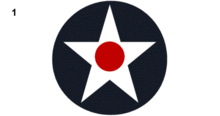
Picture - Roundels that have appeared on US aircraft 1) 5/17-2/18 2) 2/18-8/19 3) 8/19-5/42 4) 5/42-6/43 5) 6/43-9/43 6) 9/43-1/47 7) 1/47-
The predecessor organizations of today's USAF are:
Aeronautical Division, U.S. Signal Corps (August 1, 1907 to July 18, 1914)
Aviation Section, U.S. Signal Corps (July 18, 1914 to May 20, 1918)
Division of Military Aeronautics (May 20, 1918 to May 24, 1918)
U.S. Army Air Service (May 24, 1918 to July 2, 1926)
U.S. Army Air Corps (July 2, 1926 to June 20, 1941) and
U.S. Army Air Forces (June 20, 1941 to September 17, 1947)
Recent history
Since 2005, the USAF has placed a strong focus on the improvement of Basic Military Training (BMT). While the intense training has become longer it also has shifted to include a deployment phase. This deployment phase, now called the BEAST, places the trainees in a surreal environment that they may experience once they deploy. While the trainees do tackle the massive obstacle courses along with the BEAST, the other portions include defending and protecting their base of operations, forming a structure of leadership, directing search and recovery, and basic self aid buddy care. During this event, the Military Training Instructors (MTI) act as mentors and enemy forces in a deployment exercise.
In 2007, the USAF undertook a reduction-in-force. Because of budget constraints, the USAF planned to reduce the service's size from 360,000 active duty personnel to 316,000. The size of the active-duty force in 2007 was roughly 64% of that of the USAF at the end of the Gulf War in 1991. However, the reduction was ended at approximately 330,000 personnel in 2008 to meet mission requirements. These same constraints have seen a sharp reduction in flight hours for crew training since 2005 and the Deputy Chief of Staff for Manpower and Personnel directing Airmen's Time Assessments.
On June 5, 2008, Secretary of Defense Robert M. Gates, accepted the resignations of both the Secretary of the Air Force, Michael W. Wynne, and the Chief of Staff of the United States Air Force, Gen. T. Michael Moseley. Gates in effect fired both men for "systemic issues associated with declining Air Force nuclear mission focus and performance". This followed an investigation into two embarrassing incidents involving mishandling of nuclear weapons, and were also the culmination of disputes between the Air Force leadership and Gates. To put more emphasis on nuclear assets, the USAF established the nuclear-focused Air Force Global Strike Command on 24 October 2008.
On June 26, 2009, the USAF released a force structure plan that cuts fighter aircraft and shifts resources to better support nuclear, irregular and information warfare. On July 23, 2009, The USAF released their Unmanned Aerial System Flight Plan, detailing UAV plans through 2047. One third of the planes that the USAF plans to buy in the future are to be unmanned.
In recent years the USAF has fumbled several high profile aircraft procurement projects, such as the failure to make the case for the Next-Generation Bomber, the failure to control costs on the Lockheed Martin F-22 Raptor and the decade of failures on the KC-X program. Winslow Wheeler has written that this pattern represents "failures of intellect and -- much more importantly -- ethics."
Conflicts
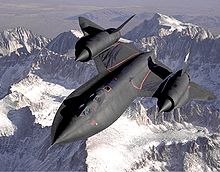
Picture - The SR-71 Blackbird was a Cold war reconnaissance plane.
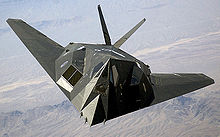
Picture - The F-117 Nighthawk was a stealth attack aircraft (retired from service on 22 April 2008).
The United States has been involved in many wars, conflicts and operations using military air operations. Air combat operations before, and since the official conception of the USAF include:
World War I as Aviation Section, U.S. Signal Corps
World War II as United States Army Air Forces
Cold War
Korean War
Vietnam War
Operation Eagle Claw (1980 Iranian Hostage Rescue)
Operation Urgent Fury (1983 US Invasion of Grenada)
Operation El Dorado Canyon (1986 US Bombing of Libya)
Operation Just Cause (1989-1990 US Invasion of Panama)
Operation Desert Shield and Operation Desert Storm (1990-1991 Persian Gulf War)
Operation Southern Watch (1992-2003 Iraq No-Fly Zone)
Operation Deliberate Force (1995 NATO bombing in Bosnia and Herzegovina)
Operation Northern Watch (1997-2003 Iraq No-Fly Zone)
Operation Allied Force (1999 NATO bombing of Yugoslavia)
Operation Enduring Freedom (2001-present Afghanistan War)
Operation Iraqi Freedom (2003-2010 Iraq War)
Humanitarian operations
The USAF has also taken part in numerous humanitarian operations. Some of the more major ones include the following:
Berlin Airlift (Operation Vittles), 1948-1949
Operation Safe Haven, 1956-1957
Operations Babylift, New Life, Frequent Wind, and New Arrivals, 1975
Operation Provide Comfort, 1991
Operation Sea Angel, 1991
Operation Provide Hope, 1992-1993
Operation Unified Assistance, December 2004 - April 2005
Operation Unified Response, January 14, 2010-present
Organization
Administrative organization
The USAF is one of three service departments, and is managed by the civilian Department of the Air Force. Guidance is provided by the Secretary of the Air Force (SECAF) and the Secretary's staff and advisors. The military leadership is the Air Staff, led by the Chief of Staff.
USAF direct subordinate commands and units are the Field Operating Agency (FOA), Direct Reporting Unit (DRU), and the currently unused Separate Operating Agency.
The Major Command (MAJCOM) is the superior hierarchical level of command. Including the Air Force Reserve Command, as of September 30, 2006, USAF has ten major commands. The Numbered Air Force (NAF) is a level of command directly under the MAJCOM, followed by Operational Command (now unused), Air Division (also now unused), Wing, Group, Squadron, and Flight.
Force structure (Major Commands)
Headquarters, United States Air Force, The Pentagon, Arlington County, Virginia
Air Combat Command (ACC), headquartered at Joint Base Langley-Eustis, Virginia
First Air Force, headquartered at Tyndall Air Force Base, Panama City, Florida
Ninth Air Force, headquartered at Shaw Air Force Base, South Carolina
Twelfth Air Force, headquartered at Davis-Monthan Air Force Base, Tucson, Arizona
United States Air Force Warfare Center, headquartered at Nellis Air Force Base, Nevada
Air Education and Training Command (AETC), headquartered at Randolph Air Force Base, San Antonio, Texas
Second Air Force, headquartered at Keesler Air Force Base, Biloxi, Mississippi
Nineteenth Air Force, headquartered at Randolph Air Force Base, San Antonio, Texas
Air Force Recruiting Service, headquartered at Randolph Air Force Base, San Antonio, Texas
The Air University, headquartered at Maxwell Air Force Base, Montgomery, Alabama
Wilford Hall Medical Center, headquarted at Lackland Air Force Base, San Antonio, Texas
Air Force Global Strike Command (AFGSC), headquartered at Barksdale Air Force Base, Louisiana
Eighth Air Force, headquartered at Barksdale Air Force Base, Louisiana
Twentieth Air Force, headquartered at Francis E. Warren Air Force Base, Cheyenne, Wyoming
Air Force Materiel Command (AFMC), headquartered at Wright-Patterson Air Force Base, Dayton, Ohio
Aeronautical Systems Center, headquartered at Wright-Patterson Air Force Base, Dayton, Ohio
Air Force Flight Test Center, headquartered at Edwards Air Force Base, Palmdale, California
Air Force Global Logistics Support Center, headquartered at Scott Air Force Base, Belleville, Illinois
Air Force Nuclear Weapons Center, headquartered at Kirtland Air Force Base, Albuquerque, New Mexico
Air Force Research Laboratory, headquartered at Wright-Patterson Air Force Base, Dayton, Ohio
Air Force Security Assistance Center, headquartered at Wright-Patterson Air Force Base, Dayton, Ohio
Air Armament Center, headquartered at Eglin Air Force Base, Fort Walton Beach, Florida
Arnold Engineering Development Center, located at Arnold Air Force Base, Manchester, Tennessee
Electronic Systems Center, headquartered at Hanscom Air Force Base, Massachusetts
Air Force Reserve Command (AFRC), headquartered at Robins Air Force Base, Georgia
Fourth Air Force, headquartered at March Air Reserve Base, Southern California
Tenth Air Force, headquartered at the Naval Air Station Joint Reserve Base Fort Worth, Texas
Twenty-Second Air Force, headquartered at Dobbins Air Reserve Base, Georgia
Air Reserve Personnel Center, headquartered at Denver, Colorado
Air Force Space Command (AFSPC), headquartered at Peterson Air Force Base, Colorado Springs, Colorado
Fourteenth Air Force, headquartered at Vandenberg Air Force Base, Lompoc, California
Twenty-Fourth Air Force, headquarters at Lackland Air Force Base, San Antonio, Texas
Space and Missile Systems Center, headquartered at Los Angeles Air Force Base, El Segundo, California
Space Innovation and Development Center, headquartered at Schriever Air Force Base, Colorado
Air Force Network Integration Center, headquartered at Scott Air Force Base, Illinois

Picture - Several aircraft in a squadron at Hurlburt Field
Air Force Special Operations Command (AFSOC), headquartered at Hurlburt Field, Florida
Twenty-Third Air Force, headquartered at Hurlburt Field, Florida
Special Operations Training Center, headquartered at Hurlburt Field, Florida
Air Mobility Command (AMC), headquartered at Scott Air Force Base, Belleville, Illinois
Eighteenth Air Force, headquartered at Scott Air Force Base, Belleville, Illinois
United States Air Force Expeditionary Center, headquartered at Joint Base McGuire-Dix-Lakehurst, New Jersey
United States Air Forces in Europe (USAFE), headquartered at Ramstein Air Base, Germany
Third Air Force, headquartered at Ramstein Air Base, Germany
Seventeenth Air Force, headquartered at Ramstein Air Base, Germany
Pacific Air Forces (PACAF), headquartered at Joint Base Pearl Harbor-Hickam, Hawaii
Fifth Air Force, headquartered at Yokota Air Base, Japan
Seventh Air Force, headquartered at Osan Air Base, South Korea
Eleventh Air Force, headquartered at Elmendorf Air Force Base, Anchorage, Alaska
Thirteenth Air Force, headquartered at Joint Base Pearl Harbor-Hickam, Hawaii
The major components of the U.S. Air Force, as of September 30, 2006, are the following:
Active duty forces
57 flying wings, eight space wings, and 55 non-flying wings
nine flying groups, eight non-flying groups
134 flying squadrons, 43 space squadrons
Air Force Reserve
35 flying wings, one space wing
four flying groups
67 flying squadrons, six space squadrons
Air National Guard
87 flying wings
101 flying squadrons, four space squadrons
The USAF, including its Air Force Reserve components, possesses a total of 302 flying squadrons.
Operational organization
List of active United States Air Force aircraft squadrons
The above organizational structure is responsible for the peacetime organization, equipping, and training of aerospace units for operational missions. When required to support operational missions, the National Command Authority directs a Change in Operational Control (CHOP) of these units from their peacetime alignment to a Regional Combatant Commander (CCDR). In the case of AFSPC, AFSOC, PACAF, and USAFE units, forces are normally employed in-place under their existing CCDR. Likewise, AMC forces operating in support roles retain their componency to USTRANSCOM unless chopped to a Regional CCDR.
Aerospace Expeditionary Task Force
"Chopped" units are referred to as forces. The top-level structure of these forces is the Air and Space Expeditionary Task Force (AETF). The AETF is the Air Force presentation of forces to a CCDR for the employment of Air Power. Each CCDR is supported by a standing Component Numbered Air Force (C-NAF) to provide planning and execution of aerospace forces in support of CCDR requirements. Each C-NAF consists of a Commander, Air Force Forces (COMAFFOR) and AFFOR/A-staff, and an Air Operations Center (AOC). As needed to support multiple Joint Force Commanders (JFC) in the COCOM's Area of Responsibility (AOR), the C-NAF may deploy Air Component Coordinate Elements (ACCE) to liaise with the JFC. If the Air Force possesses the preponderance of air forces in a JFC's area of operations, the COMAFFOR will also serve as the Joint Forces Air Component Commander (JFACC).
Commander, Air Force Forces
The Commander, Air Force Forces (COMAFFOR) is the senior USAF officer responsible for the employment of air power in support of JFC objectives. The COMAFFOR has a special staff and an A-Staff to ensure assigned or attached forces are properly organized, equipped, and trained to support the operational mission.
Air Operations Center
The Air Operations Center (AOC) is the JFACC's Command and Control (C2) center. This center is responsible for planning and executing air power missions in support of JFC objectives.
Air Expeditionary Wings/Groups/Squadrons
The AETF generates air power to support COCOM objectives from Air Expeditionary Wings (AEW) or Air Expeditionary Groups (AEG). These units are responsible for receiving combat forces from Air Force MAJCOMs, preparing these forces for operational missions, launching and recovering these forces, and eventually returning forces to the MAJCOMs. Theater Air Control Systems control employment of forces during these missions.
Personnel
The classification of any USAF job is the Air Force Specialty Code (AFSC). They range from flight combat operations such as a gunner, to working in a dining facility to ensure that members are properly fed. There are many different jobs in fields such as computer specialties, mechanic specialties, enlisted aircrew, communication systems, avionics technicians, medical specialties, civil engineering, public affairs, hospitality, law, drug counseling, mail operations, security forces, and search and rescue specialties.
Perhaps the most dangerous USAF jobs are Explosive Ordnance Disposal (EOD), Combat rescue officer, Pararescue, Security Forces, Combat Control, Combat Weather, Tactical Air Control Party, and AFOSI agents, who deploy with infantry and special operations units who disarm bombs, rescue downed or isolated personnel, call in air strikes and set up landing zones in forward locations. Most of these are enlisted positions. Other jobs have seen increasing combat, including engineers, vehicle operators, and OSI.
Nearly all enlisted jobs are "entry level," meaning that the USAF provides all training. Some enlistees are able to choose a particular job, or at least a field before actually joining, while others are assigned an AFSC at Basic Military Training (BMT). After BMT, new airmen attend a technical training school where they learn their particular AFSC. Second Air Force, a part of Air Education and Training Command, is responsible for nearly all technical training.
Training programs vary in length; for example, 3M0X1 (Services) has 31 days of tech school training, while 3E8X1 (Explosive Ordnance Disposal) is one year of training with a preliminary school and a main school consisting of over 10 separate divisions, sometimes taking students close to two years to complete.
USAF rank is divided between enlisted airmen, non-commissioned officers, and commissioned officers, and ranges from the enlisted Airman Basic (E-1) to the commissioned rank of General (O-10). Enlisted promotions are granted based on a combination of test scores, years of experience, and selection board approval while officer promotions are based on time-in-grade and a promotion board. Promotions among enlisted personnel and non-commissioned officers are generally designated by increasing numbers of insignia chevrons. Commissioned officer rank is designated by bars, oak leaves, a silver eagle, and anywhere from one to four stars (one to five stars in war-time).
Commissioned officers
The commissioned officer ranks of the USAF are divided into three sections: company grade, field grade, and general officers. Company grade officers are those officers in pay grades O-1 to O-3, while field grade officers are those in pay grades O-4 to O-6, and general officers are those in pay grades of O-7 and above.
Currently, promotion from Second Lieutenant to First Lieutenant is virtually guaranteed after two years of satisfactory service. The promotion from First Lieutenant to Captain is competitive after successfully completing another two years of service. Promotion to Major and above is through a board process. An officer's record is reviewed by a selection board at the Air Force Personnel Center at Randolph Air Force Base in San Antonio, Texas. This process occurs approximately between the seven- and ten-year mark, where a certain percentage of Captains will be selected for Major. This process will repeat at the 11-14 year mark for promotion to Lieutenant Colonel, and then around the eighteen-year mark for promotion to Colonel.
Awarded as an honorary rank or during periods of a declared war. No periods are used in actual grade abbreviation.
Warrant officers
Although provision is made in regulations for them, the USAF does not use warrant officer grades (the only armed service to not do so). The USAF inherited warrant officer ranks from the Army at its inception in 1947, but their place in the Air Force structure was never made clear. When Congress authorized the creation of two new senior enlisted ranks in 1958, Air Force officials privately concluded that these two new "super grades" could fill all Air Force needs then performed at the warrant officer level, although this was not publicly acknowledged until years later. The Air Force stopped appointing warrant officers in 1959, the same year the first promotions were made to the new top enlisted grade, Chief Master Sergeant. Most of the existing Air Force warrant officers entered the commissioned officer ranks during the 1960s, but tiny numbers continued to exist for the next 21 years.
The last active duty Air Force warrant officer, CWO4 James H. Long, retired in 1980 and the last Air Force Reserve warrant officer, CWO4 Bob Barrow, retired in 1992. Upon his retirement, he was honorarily promoted to CWO5, the only person in the Air Force ever to hold this grade. Barrow died in April 2008. Since Barrow's retirement, the Air Force warrant officer ranks, while still authorized by law, are not used.
Enlisted airmen
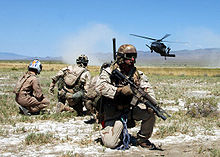
Picture - Pararescuemen and a simulated “survivor” watch as an HH-60G Pave Hawk helicopter comes in for a landing.
Enlisted members of the USAF have pay grades from E-1 (entry level) to E-9 (senior enlisted). While all USAF military personnel are referred to as Airmen, the term also refers to the pay grades of E-1 through E-4, which are below the level of non-commissioned officers (NCOs). Above the pay grade of E-4 (i.e., pay grades E-5 through E-9) all ranks fall into the category of NCO and are further subdivided into NCOs (pay grades E-5 and E-6) and Senior NCOs (pay grades E-7 through E-9); the term Junior NCO is sometimes used to refer to staff sergeants and technical sergeants (pay grades E-5 and E-6).
The USAF is the only of the five branches of the United States military where NCO status is not achieved until an airman reaches the pay grade of E-5. In all other branches, NCO status is generally achieved at the pay grade of E-4 (e.g., a Corporal in the Army and Marine Corps, Petty Officer Third Class in the Navy and Coast Guard). However, E-4s in the Army with the rank of Specialist are not considered NCOs. The Air Force mirrored the Army from 1976 to 1991 with an E-4 being either a Senior Airman wearing three stripes without a star or a Sergeant (referred to as "Buck Sergeant"), which was noted by the presence of the central star and considered an NCO. Despite not being an NCO, a Senior Airman who has completed Airman Leadership School can be a supervisor.
ą The USAF does not have a separate First Sergeant rank; it is instead a duty denoted by a diamond within the upper field.
Uniforms
USAF personnel wear uniforms that are distinct from those of the other branches of the United States armed forces. The first USAF dress uniform, in 1947, was dubbed and patented "Uxbridge Blue" after "Uxbridge 1683 Blue", developed at the former Bachman-Uxbridge Worsted Company. The current Service Dress Uniform, which was adopted in 1993 and standardized in 1995, consists of a three-button, pocketless coat, similar to that of a men's "sport jacket" (with silver "U.S." pins on the lapels), matching trousers, and either a service cap or flight cap, all in Shade 1620, "Air Force Blue" (a darker purplish-blue). This is worn with a light blue shirt (Shade 1550) and Shade 1620 herringbone patterned necktie. Enlisted members wear sleeve insignia on both the jacket and shirt, while officers wear metal rank insignia pinned onto the coat, and Air Force Blue slide-on epaulet loops on the shirt. USAF personnel assigned to Base Honor Guard duties wear, for certain occasions, a modified version of the standard service dress uniform, but with silver trim on the sleeves and trousers, with the addition of a ceremonial belt (if necessary), wheel cap with silver trim and Hap Arnold Device, and a silver aiguillette placed on the left shoulder seam and all devices and accoutrement.
The current utility uniform is called the Airman Battle Uniform (ABU). The previous utility uniform called the Battle Dress Uniform (BDU) is still authorized for wear but is becoming less common. The ABU is scheduled to completely replace the BDU by October 1, 2011 (Fiscal Year 2012).
Awards and badges
In addition to basic uniform clothing, various badges are used by the USAF to indicate a job assignment or qualification-level for a given assignment. Badges can also be used as merit-based or service-based awards. Over time, various badges have been discontinued and are no longer distributed. Authorized badges include the Shields of USAF Fire Protection, and Security Forces, and the Missile badge, which is given after working on a missile system for over a year.
Training
All non-prior service enlisted Airmen must undergo basic military training (BMT), which takes place at Lackland Air Force Base in Texas. All officers are commissioned through the United States Air Force Academy, Air Force Officer Training School, Academy of Military Science, or the Air Force Reserve Officer Training Corps program. But If you are an officer through the healthcare, legal or religious sectors, you will go through the Commissioned Officer Training program.
Air Force Fitness Test
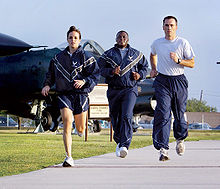
Picture - USAF members training at Lackland AFB
The US Air Force Fitness Test (AFFT) is designed to test the abdominal cicumference, muscular strength/endurance and cardiovascular respiratory fitness of airmen in the USAF. As part of the Fit to Fight program, the USAF adopted a more stringent physical fitness assessment; the new fitness program was put into effect on June 1, 2010, and replaced the annual ergo-cycle test which the USAF had used for several years. In the AFFT, Airmen are given a score based on performance consisting of four components: waist circumference, the sit-up, the push-up, and a 1.5-mile (2.4 km) run. Airmen can potentially earn a score of 100, with the run counting as 60%, waist circumference as 20%, and both strength test counting as 10% each. A passing score is 75 points. Effective July 1, 2010, the AFFT will be administered by the base Fitness Assessment Cell (FAC), and will be required twice a year. Personnel may test once a year if he or she earns a score above a 90%. Additionally, only meeting the minimum standards on each one of these test will not get you a passing score of 75%.
Aircraft inventory
The US Air Force has over 5,778 aircraft commissioned as of 2004. Until 1962, the Army and Air Force maintained one system of aircraft naming, while the U.S. Navy maintained a separate system. In 1962, these were unified into a single system heavily reflecting the Army/Air Force method. For more complete information on the workings of this system, refer to United States Department of Defense aerospace vehicle designation. The various aircraft of the Air Force include:
A - Ground attack
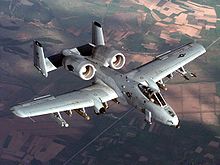
Picture - A-10 Thunderbolt II ground attack aircraft.
The ground-attack aircraft of the USAF are designed to attack targets on the ground and are often deployed as close air support for, and in proximity to, U.S. ground forces. The proximity to friendly forces require precision strikes from these aircraft that are not possible with bomber aircraft listed below. They are typically deployed as close air support to ground forces, their role is tactical rather than strategic, operating at the front of the battle rather than against targets deeper in the enemy's rear.
A-10A/C Thunderbolt II
AC-130H/U Spectre/Spooky II
B - Bombers
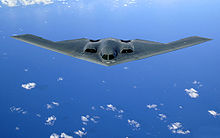
Picture - B-2 Spirit stealth strategic bomber.
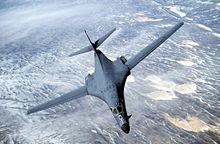
Picture - B-1 Lancer supersonic strategic bomber.
In the US Air Force, the distinction between bombers, fighter-bombers, and attack aircraft has become blurred. Many attack aircraft, even ones that look like fighters, are optimized to drop bombs, with very little ability to engage in aerial combat. Many fighter aircraft, such as the F-16, are often used as 'bomb trucks', despite being designed for aerial combat. Perhaps the one meaningful distinction at present is the question of range: a bomber is generally a long-range aircraft capable of striking targets deep within enemy territory, whereas fighter bombers and attack aircraft are limited to 'theater' missions in and around the immediate area of battlefield combat. Even that distinction is muddied by the availability of aerial refueling, which greatly increases the potential radius of combat operations. The US is the only country, besides Russia, that operates strategic bombers.
The B-52 Stratofortress airframe is over 50 years old, and are scheduled to remain in service for another 30 years, which would keep the airframe in service for nearly 90 years, an unprecedented length of service for any aircraft. Plans for successors to the current strategic bomber force remain only paper projects, and political and funding pressures suggest that they are likely to remain paper-bound for the foreseeable future.
B-1B Lancer
B-2A Spirit
B-52H Stratofortress
C - Cargo transport
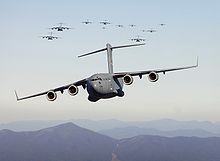
Picture - C-17 Globemaster III, the USAF's newest and most versatile transport plane.
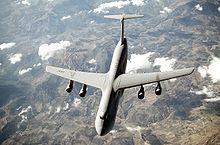
Picture - C-5 Galaxy heavy airlift.

Picture - CV-22 Osprey tiltrotor aircraft.
The Air Force can provide rapid global mobility, which lies at the heart of U.S. strategy in this environment-without the capability to project forces, there is no conventional deterrent. As U.S. forces stationed overseas continue to decline, global interests remain, making the unique mobility capabilities of the USAF even more in demand. Air mobility is a national asset of growing importance for responding to emergencies and protecting American interests around the globe.
Cargo and transport aircraft are typically used to deliver troops, weapons and other military equipment by a variety of methods to any area of military operations around the world, usually outside of the commercial flight routes in uncontrolled airspace. The workhorses of the USAF Air Mobility Command are the C-130 Hercules, C-17 Globemaster III, and C-5 Galaxy. These aircraft are largely defined in terms of their range capability as strategic airlift (C-5), strategic/tactical (C-17), and tactical (C-130) airlift to reflect the needs of the land forces they most often support. The CV-22 is used by the Air Force for the U.S. Special Operations Command (USSOCOM). It conducts long-range, special operations missions, and is equipped with extra fuel tanks and terrain-following radar.
C-5A/B/C/M Galaxy
C-12C/D/F Huron
C-17A Globemaster III
C-20A/B/C Gulfstream III
C-20G/H Gulfstream IV
C-21A Learjet
C-27J Spartan
C-37A/B Gulfstream V
C-38A Courier
C-40B Clipper
C-41A Aviocar
C-47T Skytrain (6th Special Operations Squadron)
C-130E/H Hercules
C-130J Super Hercules
CV-22B Osprey
E - Special electronic missions
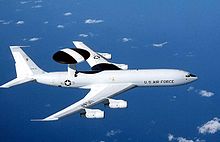
Picture - E-3 Sentry airborne warning and control system
The purpose of electronic warfare is to deny the opponent an advantage in the EMS and ensure friendly, unimpeded access to the EM spectrum portion of the information environment. Electronic warfare aircraft are used to keep airspaces friendly, and send critical information to anyone who needs it. They are often called "The Eye in the Sky."
E-3B/C Sentry
E-4B
E-8C JSTARS
E-9A
EC-130H/J Compass Call/Commando Solo
F - Fighters
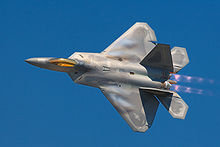
Picture - F-22 Raptor stealth air superiority fighter.
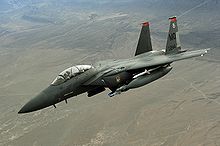
Picture - F-15 Strike Eagle strike fighter.
The fighter aircraft of the USAF are small, fast, and maneuverable military aircraft primarily used for air-to-air combat. Many of these fighters have secondary ground-attack capabilities, and some are dual-roled as fighter-bombers (e.g., the F-16 Fighting Falcon); the term "fighter" is also sometimes used colloquially for dedicated ground-attack aircraft. Other missions include interception of bombers and other fighters, reconnaissance, and patrol. Out of the 5,778 manned aircraft in service, 2,402 are fighters, and 1,245 of those are variants of the F-16 Fighting Falcon.
From 2006 to 2025, the USAF plans to reduce its inventory of tactical aircraft by 28%.
F-15C/D Eagle
F-15E Strike Eagle
F-16C/D Fighting Falcon
F-22A Raptor
H - Search and rescue
These craft are used for search and rescue and combat search and rescue on land or sea.
HC-130P/N Hercules
HH-60G/MH-60G Pave Hawk
K - Tanker
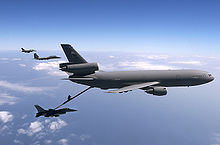
Picture - KC-10 Extender tri-jet air-to-air tanker.
The USAF's aerial refueling aircraft are derivatives of civilian jets. Usually, the aircraft providing the fuel is specially designed for the task, although refueling pods can be fitted to existing aircraft designs if the "probe and drogue" system is to be used. There is no known regular civilian in-flight refueling activity. In large-scale operations (and even daily air operations), air-to-air refueling is extensively used; fighters, bombers, and cargo aircraft rely heavily on the lesser-known "tanker" aircraft. This makes these aircraft an essential part of the Air Force's global mobility and the U.S. force projection.
KC-10A Extender
KC-135E/R/T Stratotanker
M - Multi-mission
Specialized multi-mission aircraft provide support for global special operations missions. These aircraft conduct infiltration, exfiltration, resupply, and refueling for SOF teams from improvised or otherwise short runways.
MC-130E/H/P/W Combat Talon I/Combat Talon II/Combat Shadow/Combat Spear
Multi-mission RPAs (Remote Piloted Aircraft)
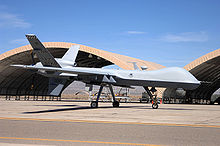
Picture - MQ-9 unmanned aerial vehicle.
Initial generations of RPAs were primarily surveillance aircraft, but some were fitted with weaponry (such as the MQ-1 Predator, which used AGM-114 Hellfire air-to-ground missiles). An armed RPA is known as an unmanned combat air vehicle (UCAV).
MQ-1 Predator
MQ-9 Reaper
O - Observation
These aircraft are modified to observe (through visual or other means) and report tactical information concerning composition and disposition of forces.
OC-135B Open Skies
R - Reconnaissance
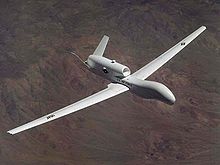
Picture - RQ-4 Global Hawk unmanned aerial vehicle reconnaissance aircraft.
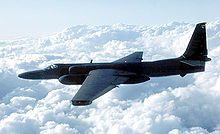
Picture - Lockheed U-2 spy plane.
The reconnaissance aircraft of the USAF are used for monitoring enemy activity, originally carrying no armament. Several unmanned remotely-controlled reconnaissance aircraft (RPAs) have been developed and deployed. Recently, the RPAs have been seen to offer the possibility of cheaper, more capable fighting machines that can be used without risk to aircrews.
Note: Although the U-2 is designated as a 'utility' aircraft, it is indeed a reconnaissance platform.
RC-26B
RC-135S/U/V/W Cobra Ball/Combat Sent/Rivet Joint/Rivet Joint
RQ-4A Global Hawk
RQ-11 Raven
RQ-170 Sentinel
U-2R/S "Dragon Lady"
T - Trainer
The Air Force's trainer aircraft are used to train pilots, navigators, and other aircrew in their duties.
T-1A Jayhawk
T-6A Texan II
(A)T-38A/B/C Talon
TG-10B/C/D
TG-15A/TG-15B
Diamond T-52A
U - Utility
Utility aircraft are used basically for what they are needed for at the time. For example, a Huey may be used to transport personnel around a large base or launch site, while it can also be used for evacuation. These aircraft are all around use aircraft.
U-28A
UH-1N Iroquois
UV-18A/B Twin Otter
V - VIP staff transport
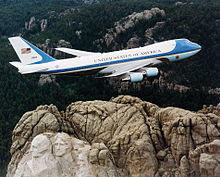
Picture - VC-25A (Air Force One).
These aircraft are used for the transportation of Very Important Persons. Notable people include the President, Vice President, secretaries, government officials (e.g., senators and representatives), the Joint Chiefs of Staff, and other key personnel.
VC-9C
VC-25A (one used as Air Force One)
C-32A/B (sometimes used as Air Force Two)
C-40B/C
W - Weather reconnaissance
These aircraft are used to study meteorological events such as hurricanes and typhoons.
WC-130J Super Hercules
WC-135C/W Constant Phoenix
Undesignated foreign aircraft used by Special Operations Squadrons
An-26 Curl (6th Special Operations Squadron)
CN-235-100 (427th Special Operations Squadron)
Mi-8 (6th Special Operations Squadron)
Culture
The culture of the United States Air Force is primarily driven by pilots and so the pilots of various aircraft types have driven its priorities over the years. At first there was a focus on bombers (driven originally by the Bomber mafia), followed by a focus on fighters (Fighter Mafia and following).
In response to the 2007 United States Air Force nuclear weapons incident, the leadership of the USAF changed, and for the first time a Chief of Staff of the United States Air Force was chosen who did not have a background as a fighter or bomber pilot. The Washington Post reported that General Schwartz has begun to dismantle the rigid class system of the USAF.
Daniel L. Magruder, Jr defines USAF culture as a combination of the rigorous application of advanced technology, individualism and progressive airpower theory. Major General Charles J. Dunlap, Jr. adds that Air Force culture includes an egalitarianism bred from officers as warriors who work with small groups of enlisted airmen either as the service crew or onboard crew of their aircraft.
Slogans and creeds
The United States Air Force has had numerous recruiting slogans including "No One Comes Close" and "Uno Ab Alto". For many years, the U.S. Air Force used "Aim High" as its recruiting slogan; more recently, they have used "Cross into the Blue", "We've been waiting for you" and "Do Something Amazing", "Above All"., and the newest one, as of October 7, 2010, considered a call and response, “Aim high” followed with the response, “Fly-Fight-Win” Each wing, group, or squadron usually has its own slogan(s). Information and logos can usually be found on the wing, group, or squadron websites.
The Air Force Core Values are: "Integrity first", "Service before self", "Excellence in all we do". The Airman's Creed is a statement introduced in the spring of 2007 to summarize the culture of the Air Force.
To help further knowledge of their mission and functions, the Air Force has also produced videos, such as "Setting the Conditions for Victory" and "How We Fight", to outline the Air Force role in the war on terrorism and how the service succeeds in its domains of air, space, and cyberspace. The Above All campaign continues to support the message of "air, space and cyberspace" dominance.
Air Force Association
Air Force Combat Ammunition Center
Air Force Knowledge Now
Civil Air Patrol
Company Grade Officers' Council
List of active United States military aircraft
List of United States Airmen
List of U.S. Air Force acronyms and expressions
List of U.S. Air Force bases
National Museum of the United States Air Force
Project Blue Book - USAF's UFO investigation (1947-1969)
U.S. Air Force Band
U.S. Air Force Chaplain Corps
U.S. Air Force Thunderbirds
United States Air Force Medical Service
United States Air Force Pararescue
References to U.S. Army predecessors of today's U.S. Air Force are cited under their respective articles.
United States Air Force Pictures and United States Air Force for Sale.
Living Warbirds: The best warbirds DVD series.
Source: WikiPedia